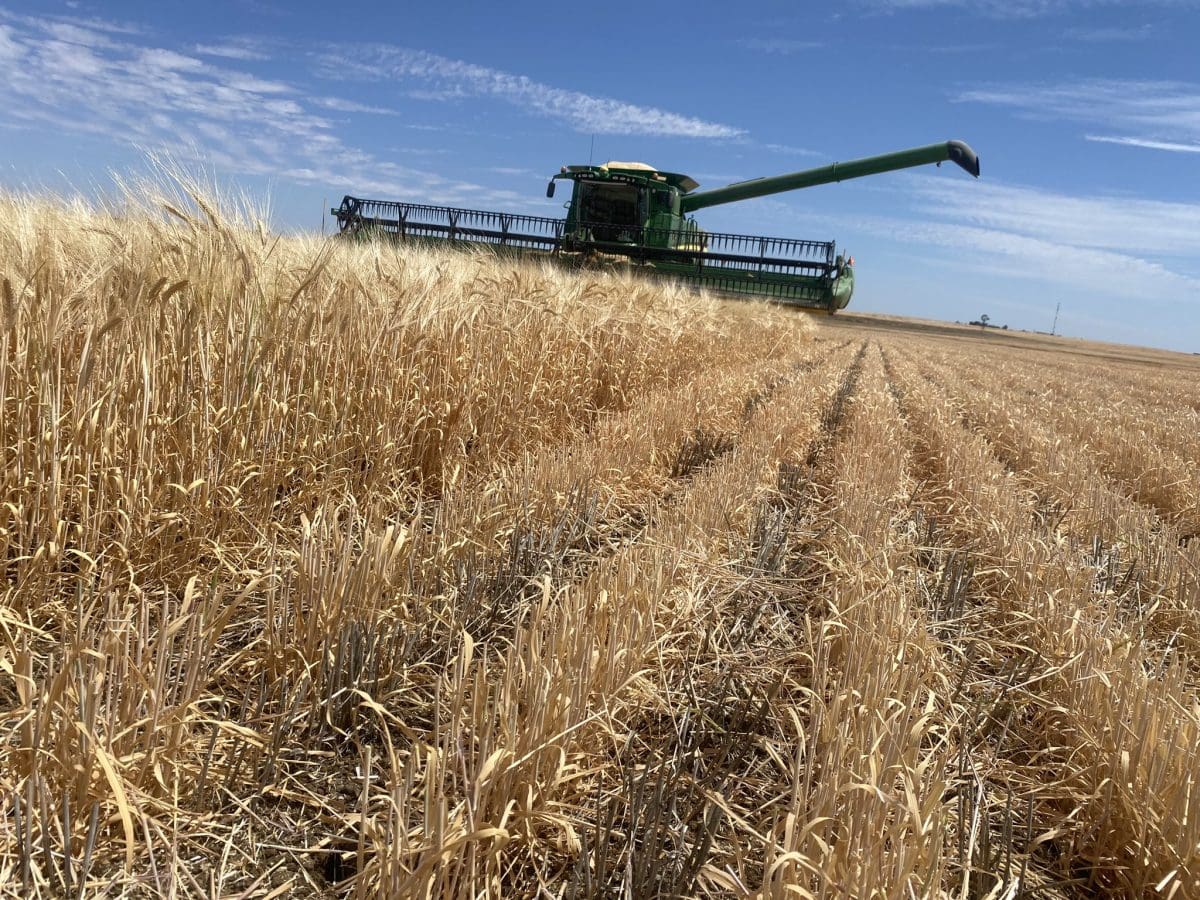
Harvesting barley last weekend in Queensland’s Maranoa region. Photo: Scott Loughnan
RAIN in the north and dry conditions in the south have seen feedgrain trade mostly sideways to firmer in the past week as growers remain reluctant sellers based on uncertainty about wheat yield and quality.
Current-crop barley remains the volume seller in the domestic market, and loads from central and southern New South Wales are continuing to price into Queensland feedlots now that rain has halted new-crop deliveries.
Nearby wheat in Queensland has rallied sharply as traders accumulate new crop for prompt export, and this has further increased the attractiveness of barley at maximum inclusion rates.
| Nearby | New-crop | |
| Barley Downs | $285 up $1 | $295 up $7 |
| Wheat Downs | $350 up $18 | $332 down $3 |
| Sorghum Downs | $305 steady | $285 steady |
| Barley Melbourne | $282 up $2 | $290 steady |
| Wheat Melbourne | $350 steady | $340 steady |
Table 1: Indicative delivered prices in Australian dollars per tonne.
Rain stops northern harvest
Rain in northern New South Wales and southern Queensland has stopped the early harvest of barley for a few days at least.
NSW registrations in the week to 9am today, and mostly in the past 48 hours, include: Moree and Mungindi 59mm; Narrabri 27mm; Parkes 36mm; Walgett 60mm, and Young 38mm.
In Queensland, falls were patchier and lighter, and include: Dalby 5mm; Emerald 10mm; Roma 20mm; Springsure 7mm, and Surat 37mm.
In northern NSW, Stewarts Grain trader Robert Quinn said falls of 40-50mm over much of the north-west plains and beyond the Queensland border have stopped the early barley harvest.
“The barley harvest had started at Talwood, but it’s stopped because of the rain, and it probably won’t get going again until Monday,” Mr Quinn said.
Provided further rain does not fall, the north-west NSW barley harvest will be going at pace in two weeks.
Prior to the rain, barley south and west of Downs feedlots had been trading at $240-$245/t off the header.
Mr Quinn said loads of old-crop barley coming from Parkes and points west and south were keeping a lid on prices.
“Barley prices haven’t done much; there’s still a bit around from the big harvest last year, and it’s been coming north non-stop.”
“The wheat supply is a different story.
“There’s not much old-crop wheat left, and what there is is all going to Brisbane.”
Exporters are showing the market strong delivered port bids, while domestic consumers are sitting on their hands as extended forecasts are pointing to a wet harvest.
“People are buying barley, and hoping for some off-grade wheat.”
“Wheat’s of an unknown of quality.”
Another trader said consumers were aware the export interest in nearby wheat far exceeded that for barley.
“Wheat has some good underlying export demand,” the trader said.
“With barley, there’s no export space available to ship it, so it has to find a home on the east coast.”
One Queensland-based trader said growers were locking in prices on a small amount of new-crop feed wheat, even prior to harvest, as widespread rain during harvest could flood the segregation.
“They want to cover that downside risk, but they don’t want to miss out on the upside for high-protein if that develops.”
Trade in sorghum remains export focussed, and continuing demand from China is seen as supportive for new-crop prices, and an offset to planting prospects improved by this week’s rain.
Southern growers cautious
Mildura-based Horizon Grain Brokers managing director Ash Munro said concerns about the season rather than dissatisfaction with prices was keeping growers out of the new-crop market.
“We deal with growers through the north Wimmera, north-west Victoria, and the South Australian Mallee and Mid North, and crops in most of those areas are in need of a very good spring rain,” Mr Munro said.
“There are pockets of extreme dryness, and there’s been some minor frost damage, and some yield loss because it’s been so dry for most of the season.”
In the 24 hours to 9am today, storms delivered patchy rain, and registrations include: Nhill 15mm; Ouyen 13mm; Horsham, Sea Lake and Woomelang 10mm, and Ultima 51mm.
In SA, falls were generally single digit, but included: Alawoona 14mm; Crystal Brook 13mm; Karoonda 28mm, and Pinnaroo 8mm.
“Barley has set its potential, but rain would help improve some later-sown wheat yields.”
Mr Munro said growers have a smaller-than-normal proportion of their crop forward sold because they did not want to overcommit on contracted tonnage.
He said southern consumers were in the market for wheat, and were aware of the export pull.
“They are staying competitive; they can’t afford to see too much grain slip past them on its way to port.”

HAVE YOUR SAY